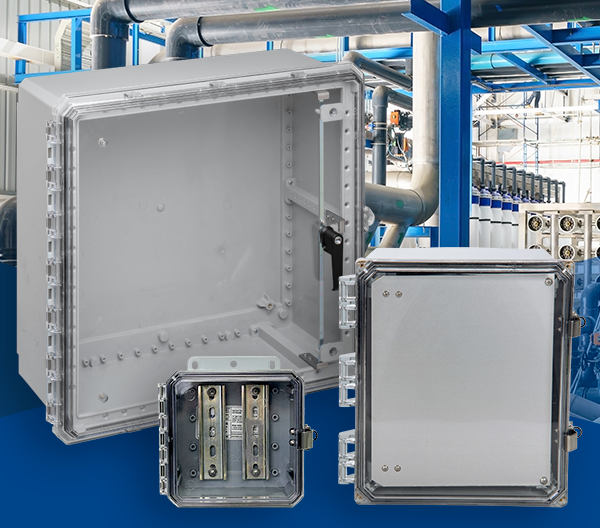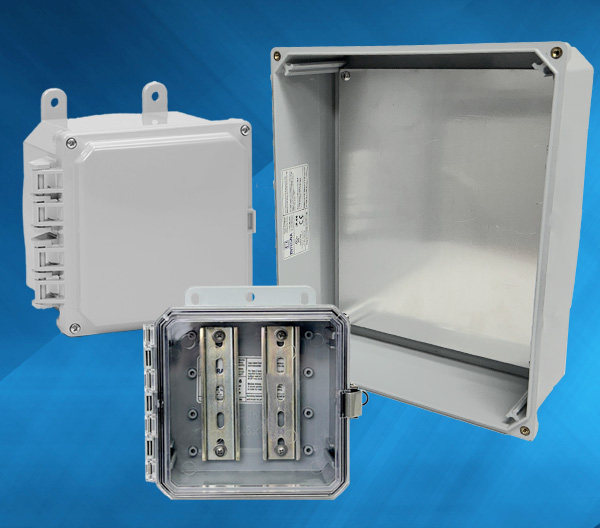Enclosures are the first, and often last, line of defense that protects sensitive electronics in the field. Whether mounted to the side of a building, buried below ground, or secured to equipment in a wet processing facility, enclosures need to hold up under challenging conditions.
The components inside are engineered to perform with precision for a long period, but none of that matters if the enclosure can’t keep contaminants out. When electrical equipment fails, the culprit is almost always the enclosure itself.
Moisture seeps in. Dust coats connectors. Systems can short or corrode. The result? Unexpected downtime, safety risks, and expensive repairs.
This is where IP ratings come into play. Short for Ingress Protection, the IP framework is the standard that engineers and facility managers use to understand the exact level of protection an enclosure offers. Unlike vague claims such as “waterproof” or “weather-resistant,” IP ratings are clear, numerical, verifiable figures that define how well electrical boxes can stand up to elements that cause corrosion, electrical shorts, and premature failure.
What is an IP Rating Chart?
The IP rating system was created in response to the need for clarity about how well an enclosure can stand up to the challenges of the environment where it’s being installed.
Created by the International Electrotechnical Commission under the IEC 60529 standard, the IP rating uses a two-digit code as a global benchmark to communicate how effective an enclosure is against intrusion.
The first digit (ranging from 0 to 6) indicates an enclosure’s ability to keep everything from fingers and sticks to ultra-fine dust particles from entering. The second numerical (ranging from 0 to 9) communicates protection against liquid ingress, from dripping water to high-pressure jets and even submersion.
For example, an IP67 enclosure offers maximum defense against solid objects and airborne particles (level 6), and Grade 7 resistance against water, making it suitable for temporary submersion.
The greatest value of this system is its ability to help specifiers make decisions based on actual risk instead of estimation. Instead of asking, “Is this enclosure waterproof?”, the better question becomes, “How well will this enclosure perform against the environmental elements it will be exposed to?”
IP Ratings Explained
No two installation environments are the same. Neither are the enclosures that protect critical electrical equipment. Dust, water spray, and submersion each come with their own challenges and risks, which is why a “one-size-fits-all” rating doesn’t exist.
The different tiers aren’t a “good–better–best” scale, but rather a quantifiable measure of protection. IP66, IP67, and IP68 are all impervious to dust. The different levels define how well an enclosure can survive water exposure — one holds up to hose spray, another can handle short submersion, and the third is made for long-term underwater placement. Each tier builds on the strengths of the level immediately prior, offering a higher degree of ingress protection.
Choosing the right rating means understanding what those differences mean with regard to real-world conditions.
|
Rating |
Dust Protection Level |
Water Protection Type |
Test Method |
Exposure Duration |
Best For |
Limitations |
|
6 = Dust-tight (no ingress) |
Powerful water jets |
Water projected at 100 L/min @ 100 kPa from a 12.5mm nozzle, from all directions |
Continuous spray (minimum 3 minutes) |
Outdoor panels, industrial machinery, construction sites, food processing areas |
Not rated for any form of submersion | |
|
6 = Dust-tight (no ingress) |
Temporary immersion |
Submersion in water up to 1 meter for 30 minutes |
Short-term only |
Marine docks, HVAC systems, and equipment exposed to temporary flooding |
Not designed for prolonged underwater exposure | |
|
6 = Dust-tight (no ingress) |
Continuous submersion |
Depth and duration specified by manufacturer (Integra enclosures are rated at 2m for 24 hours) |
Long-term or continuous |
Marine enclosures, submersible sensors, and wet infrastructure |
Performance varies by product. Verify specific depth/time with the manufacturer |
Environmental Conditions That Different Ratings Can Handle Best
Conditions in the field vary, and so do the performance needs of electrical enclosures. IP66 is well suited for rugged, dry-to-wet transitions, such as industrial plants, food processing lines, or outdoor installations that face driving rain or daily washdowns. As long as there’s no pooling water or risk of submersion, electrical enclosures with this rating are usually more than sufficient.
IP67, by contrast, is appropriate in areas with a plausible risk of flooding, high humidity, spraying or splashing — car washes, indoor rainforests, and greenhouses, for example. Equipment located near shorelines, in construction zones with unpredictable drainage, or on mobile rigs exposed to weather extremes often falls into this category as well. If the water’s going to rise, even temporarily, IP67 buys you confidence.
Then there’s IP68, which is purpose-built for prolonged exposure to water. These enclosures are designed with high-quality gaskets and strong sidewalls to ensure the cover stays sealed to the base even when subjected to high water pressures.
It’s worth noting that while these ratings protect against dust and water, they don’t account for UV exposure, chemical resistance, or extreme temperatures. Those concerns fall to material selection and mechanical design, which should be considered alongside the IP rating.
Why the Right IP Rating Matters for Long-Term Performance
Choosing the right IP rating means planning for the worst-case scenario whenever possible. Their job is to protect electronics from harm, but a mismatch between the rating and the environmental risk level can mean the shield cracks and fails. In remote or hard-to-reach places, a reliable enclosure is essential to minimize the risk of signal disruption or machine downtime.
A system designed with the right protection from the start runs longer, with fewer interruptions. That means less downtime, lower maintenance costs, and fewer emergencies.
The Right IP Rating is Just the Beginning
IP66-, IP67-, and IP68-rated enclosures might look similar at a glance, but in practice, they solve very different problems. Choosing between them is about picking the right level of protection for the job, not choosing the highest number. When environments are unpredictable, it’s best to prepare for any eventuality.
The right level of protection is too important to overlook or underestimate. At Integra, we build and work around these ratings every day. If you’re planning for long-term durability in challenging environments, we’re here to help you build in the right level of IP protection from the start. Contact us to get started.




